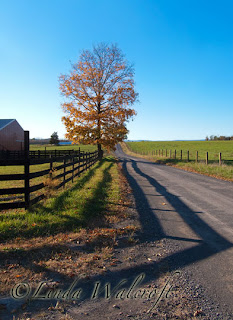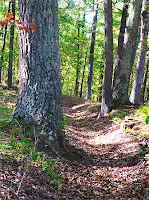Friday in Shanks, WV

We got rear-ended on Route 50 near Romney. Fortunately our injuries were minor and the only person who went to the hospital was a passenger in the vehicle that hit us. He had a broken finger. Frank was driving so I'll let him tell the story.
"A couple of cars in front of us stopped so the lead one could make a left turn. We were hit Hard from behind by a Toyota Land Cruiser (big SUV) which was travelling about 35-40 MPH. He never saw we were stopped until a split-second before he hit us. The SUV impact pushed us down the road and off on the left side, narrowly avoiding oncoming traffic. Rear third of Mazda completely demolished. Rear window shattered, both front bucket seats broken (from impact), roof and floor crumpled, frame bent, 3 of four doors jammed including the front passenger seat door (where Linda was sitting). The 2/3 full gas tank in the rear was shoved forward and down almost hitting the pavement. If it had sparked and ignited, Linda would not have been able to get out through her jammed door. It did not ignite fortunately, and we were able to get her over the console and out the driver front door. We were really lucky we weren't also hit in the front by oncoming traffic. since our car was propelled across the opposite lane to the other side of the two-lane road. Linda and I are both sore and bruised."
I saw the SUV in the mirror before it hit us. It was large and coming fast, a frightening sight! I heard the squeal of brakes and the loud crash.
People came up right away to see if we were okay. A man in the car in front of us stayed for a few minutes but he had a small child in his car to take home. (Thank God we were not propelled into the rear of their car!) The guy who hit us rushed over and was apologetic and concerned. Neighbors came out of their homes to help; a Mr. Bowman brought me a chair so I could sit down in a safe place. He and his kind wife even offered to feed us dinner and drive us home!
Rescue personnel showed up within five minutes. Yet for some reason it was over an hour before a police officer arrived, and the tow truck drivers would not remove the vehicles until he had a chance to survey the scene.
Eventually my car was towed to nearby Rogers Auto in Shanks. We were not able to obtain a rental car, so the tow truck driver took drove us to Winchester where my sister picked us up.
We are thankful that we were able to walk away from the wreckage, and we are grateful to all the folks who helped us.
 I love playing with Adobe® Photoshop®! If you're new at using filters or any special effects, remember to duplicate the background layer and make the changes on the duplicate. This not only makes it easy to delete the changes if you don't like them; it also expands your options. You can choose different ways of blending the layers and you can adjust the transparency of your new layer to make the effect more subtle. So don't be intimidated by layers. They can be fun!
I love playing with Adobe® Photoshop®! If you're new at using filters or any special effects, remember to duplicate the background layer and make the changes on the duplicate. This not only makes it easy to delete the changes if you don't like them; it also expands your options. You can choose different ways of blending the layers and you can adjust the transparency of your new layer to make the effect more subtle. So don't be intimidated by layers. They can be fun!


















































